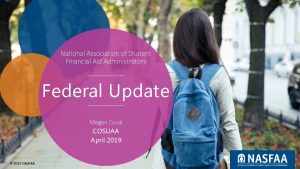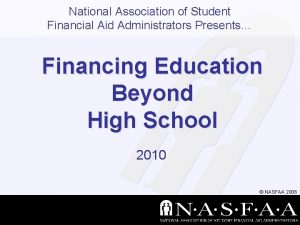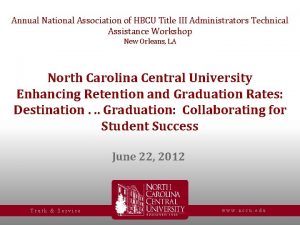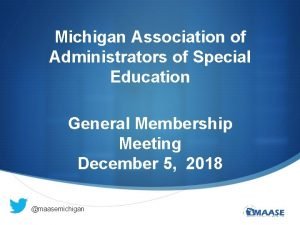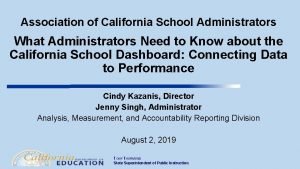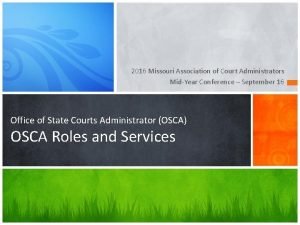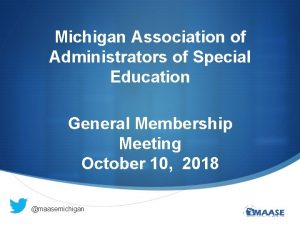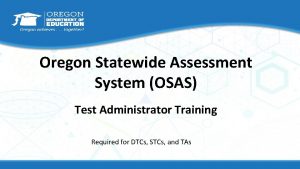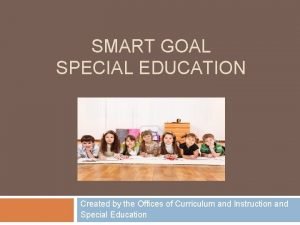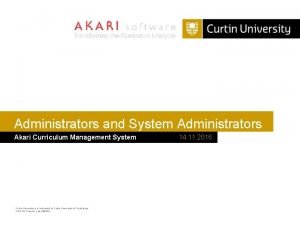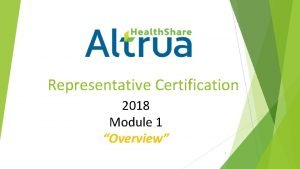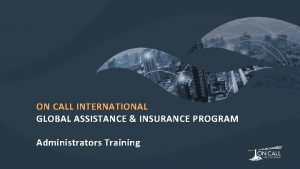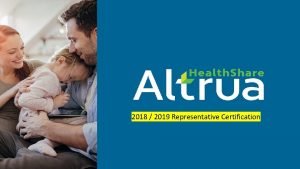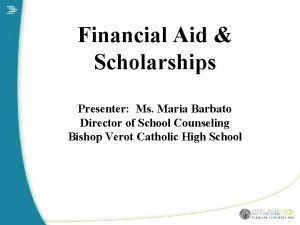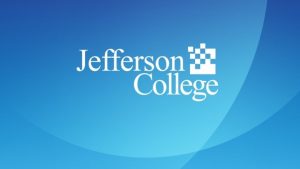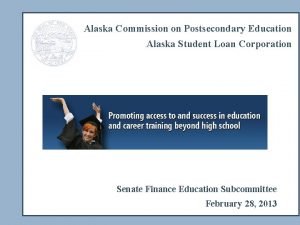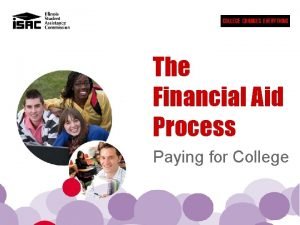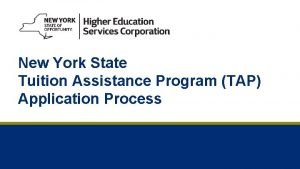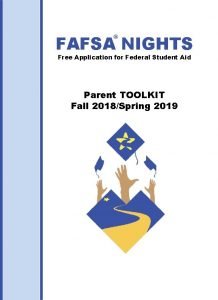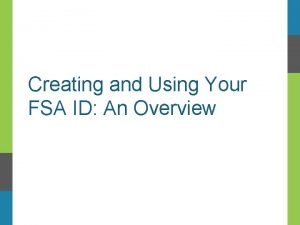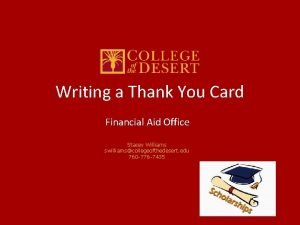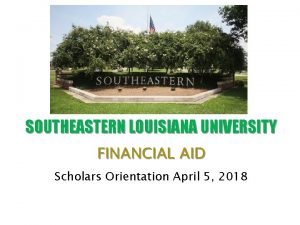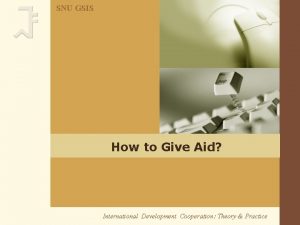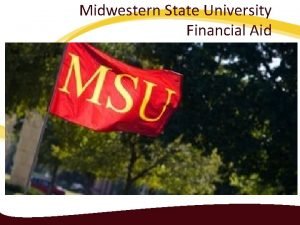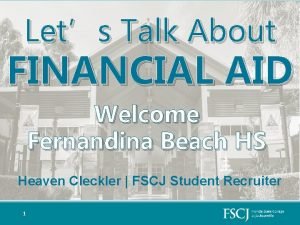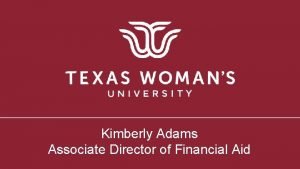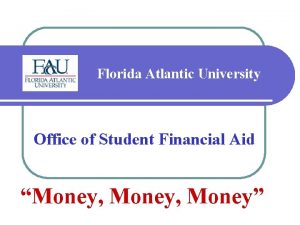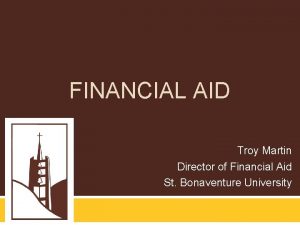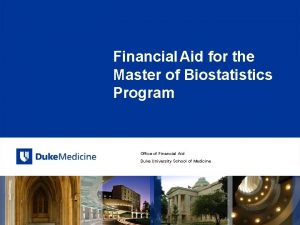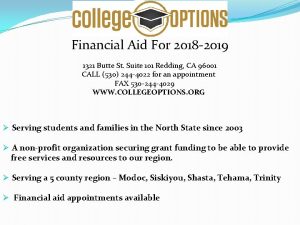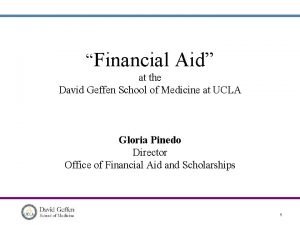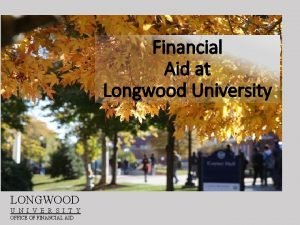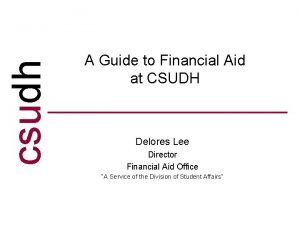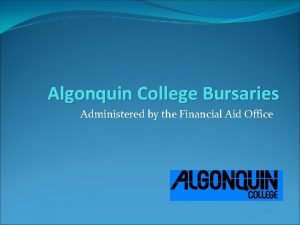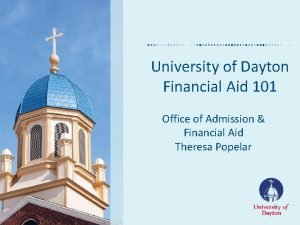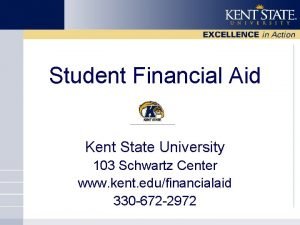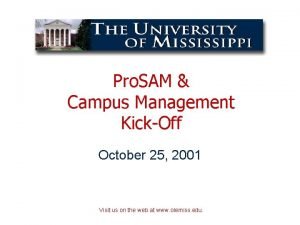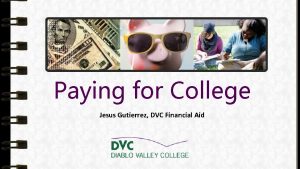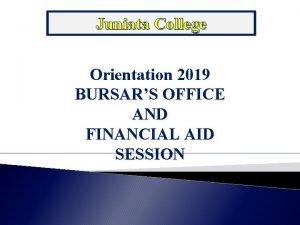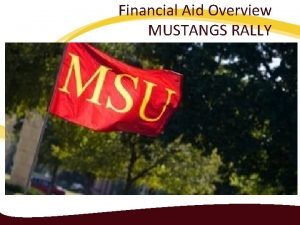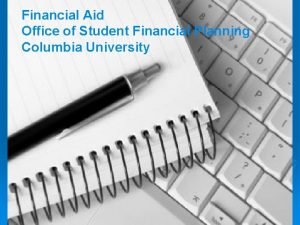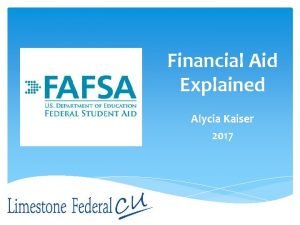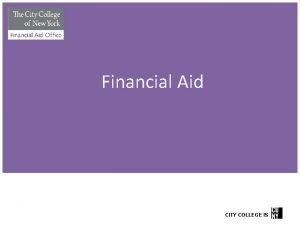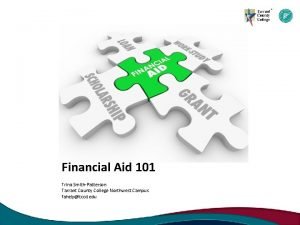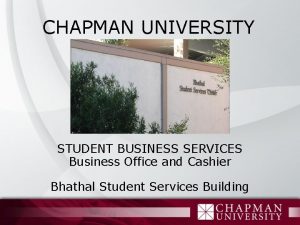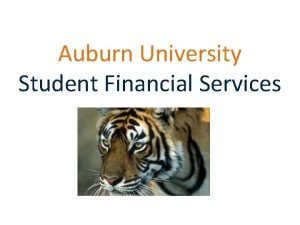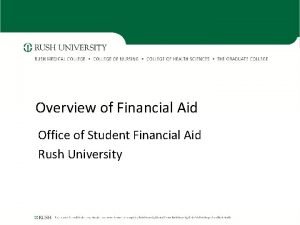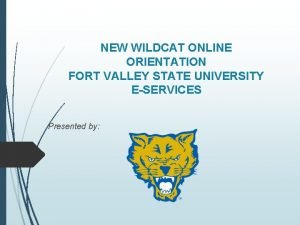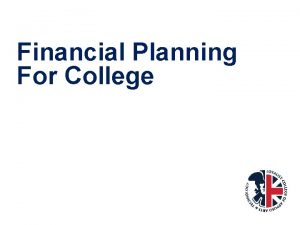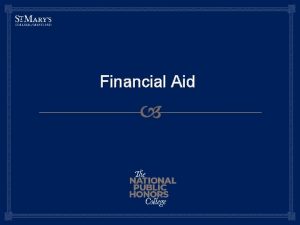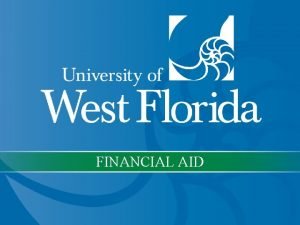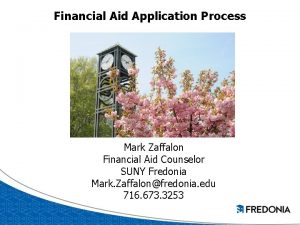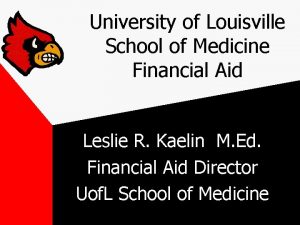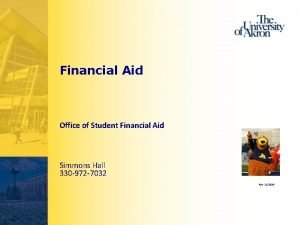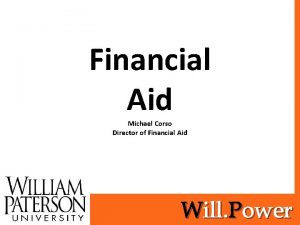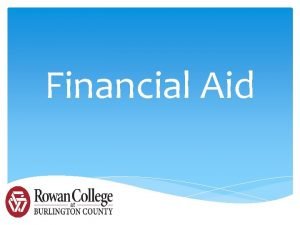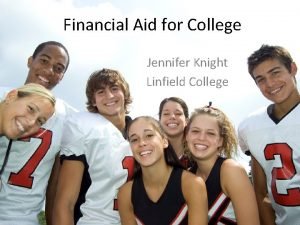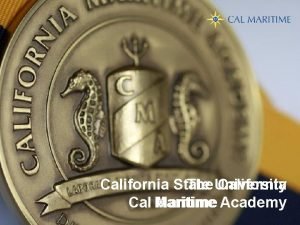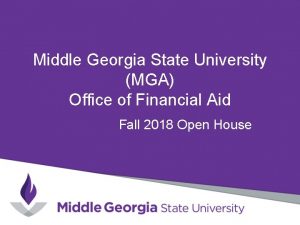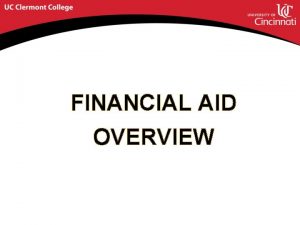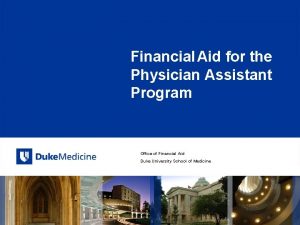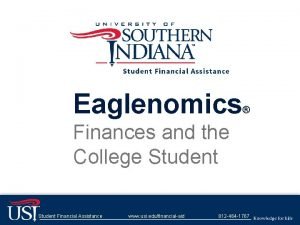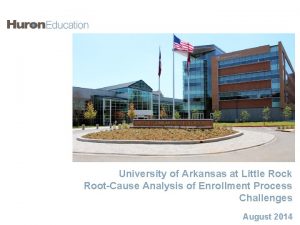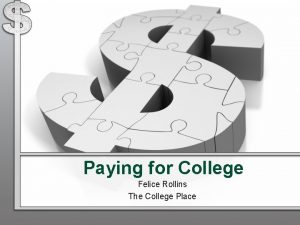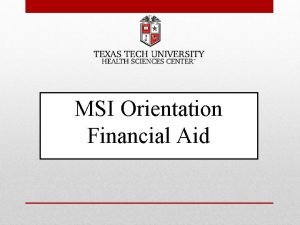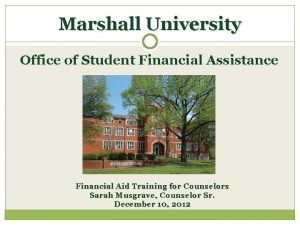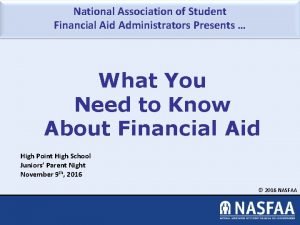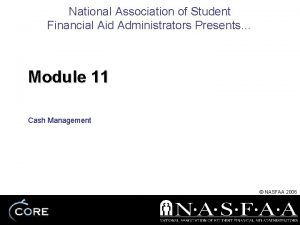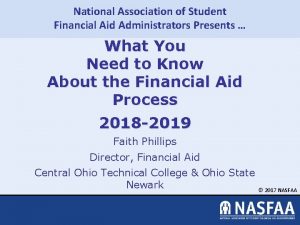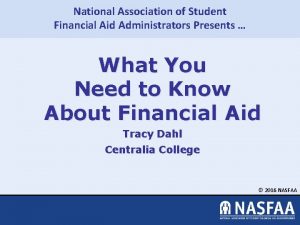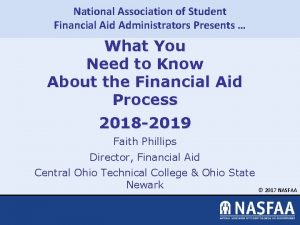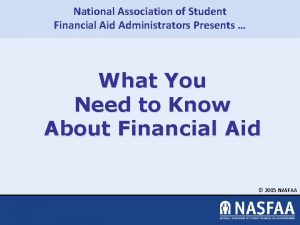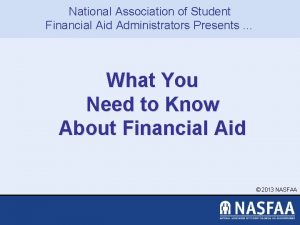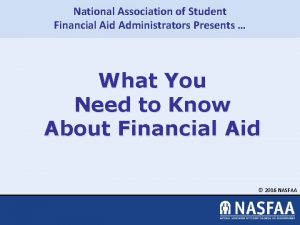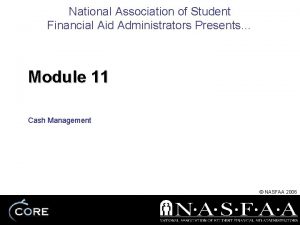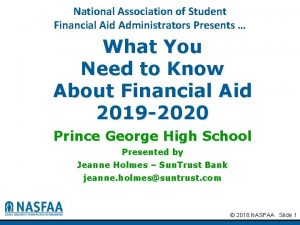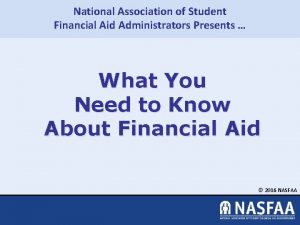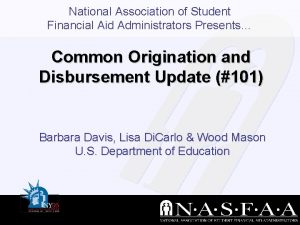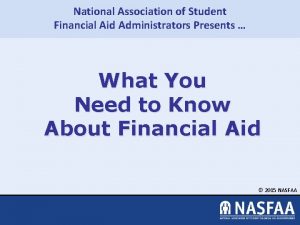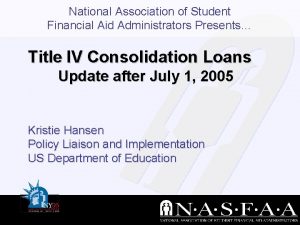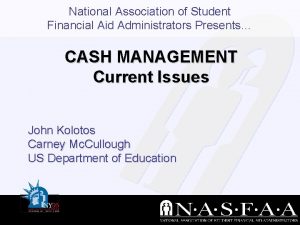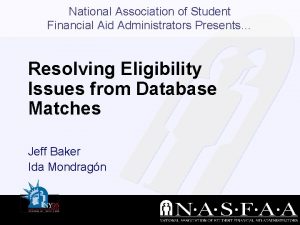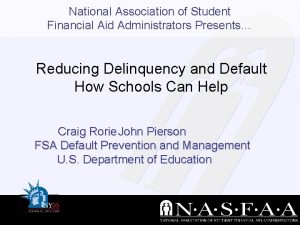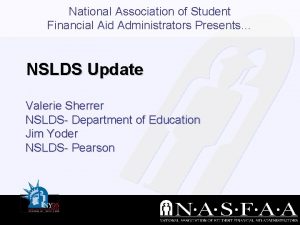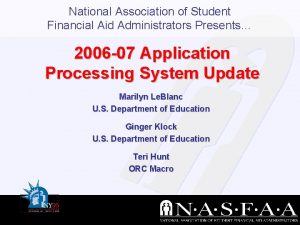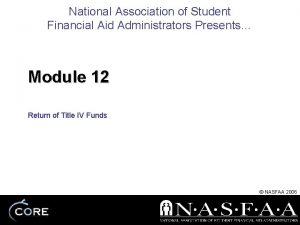National Association of Student Financial Aid Administrators Presents























































































- Slides: 87

National Association of Student Financial Aid Administrators Presents… Financing Education Beyond High School 2010 © NASFAA 2006

Financing Your Education • What is financial aid? • Where does it come from? • What aid is available? • Who is eligible? • How do I apply? Slide 2 © NASFAA 2006

Agenda • Definition of financial aid • Definition of financial need and how it is determined • Descriptions of major federal financial aid programs • How to apply for financial aid, including the Free Application for Federal Student Aid (FAFSA), and how to avoid errors • Descriptions of other government resources • Where to look for information about private sources of aid, including how to avoid being scammed Slide 3 © NASFAA 2006

What is Financial Aid? • Scholarships • Grants • Loans • Employment opportunities Slide 4 © NASFAA 2006

Types of Aid • Gift aid: Grants and scholarships (needbased or merit-based) • Self-help aid: Loans and employment (need-based or nonneed-based) Slide 5 © NASFAA 2006

Goals of Financial Aid • Primary goal is to assist students in paying for college and is achieved by: – Evaluating families’ ability to pay educational costs – Distributing limited resources in an equitable manner – Providing balance of gift aid and self-help aid Slide 6 © NASFAA 2006

Sources of Financial Aid • Federal government • States • Private sources • Civic organizations and churches • Employers Slide 7 © NASFAA 2006

Federal Government • Largest source of financial aid • Aid awarded primarily on the basis of financial need • Must apply every year using the Free Application for Federal Student Aid (FAFSA) Slide 8 © NASFAA 2006

Definition of Need Cost of attendance (COA) – Expected family contribution (EFC) = Need Slide 9 © NASFAA 2006

Cost of Attendance • Tuition and fees • Room and board • Books, supplies, transportation, and miscellaneous personal expenses, including documented costs for a personal computer • Loan fees • Study abroad costs • Dependent care expenses • Disability-related expenses • Cooperative education program costs Slide 10 © NASFAA 2006

Need Varies Based on Cost 1 1 2 2 3 3 EFC Cost of Attendance (Variable) Expected Family Contribution EFC Need (Variable) (Constant) Slide 11 © NASFAA 2006

Principles of Need Analysis • To extent they are able, parents have primary responsibility to pay for dependent child’s education • Students have a responsibility to contribute to educational costs • Families should be evaluated in their present financial condition • Family’s estimated ability to pay educational costs must be evaluated in equitable and consistent manner, recognizing that special circumstances may affect family’s ability to pay Slide 12 © NASFAA 2006

Federal Methodology is the formula created by Congress to determine the EFC. Slide 13 © NASFAA 2006

Independent Student Definition • At least 24 years old by December 31 of award year covered by the FAFSA; • Graduate or professional student; • Married; • Has children or dependents (other than a spouse) for whom the student provides more than half support; • Orphan or ward/dependent of the court; • Veteran of U. S. Armed Forces or currently serving on active duty (for other then training purposes) in the Armed Forces; or • Determined to be “independent” by financial aid administrator based on unusual circumstances Slide 14 © NASFAA 2006

EFC for a Dependent Student Step 1: Determine available parental income – – Total income (taxed and untaxed) Excludable income (e. g. , child support paid) Taxes paid (i. e. , federal, state, local, Social Security) Income protection allowance for basic living expenses (e. g. , food, shelter, etc. ) Employment allowance (if eligible) = Available income (may be negative) Slide 15 © NASFAA 2006

EFC for a Dependent Student Step 2: Determine available parental assets + + – x Value of cash, savings, and checking accounts Adjusted business/farm net worth (total value minus debt against business/farm) Investment/real estate net worth (excluding home) Education savings and asset protection allowance (determined by age of older parent) Asset conversion rate (12%) = Parental contribution from assets Slide 16 © NASFAA 2006

EFC for a Dependent Student Step 3: Determine portion of available parental income and assets available for education + = x = ÷ Available income Contribution from assets Adjusted available income (AAI) Assessment rate (varies) Total parental contribution Number attending college (excluding parents) = Parental contribution for student Slide 17 © NASFAA 2006

EFC for a Dependent Student Step 4: Determine student contribution Total income (i. e. , taxed and untaxed) – Excludable income – Taxes paid (i. e. , federal, state, local, and Social Security) – Income protection allowance – Parental adjusted available income if < $0 = Student’s available income Slide 18 © NASFAA 2006

EFC for a Dependent Student Step 4: Determine student contribution Student’s available income x 50% assessment rate = Income contribution from student + 20% of the student’s net asset worth = Student contribution Slide 19 © NASFAA 2006

EFC for a Dependent Student Parental contribution from income and assets (as adjusted, if more than one household member in college) + Student contribution from available income and assets = EFC Slide 20 © NASFAA 2006

EFC for an Independent Student • No parental contribution • Independent with dependents: – Student contribution similar to calculation for parent of dependent student – Variable percentage of available income – 7% of net assets after protection allowance • Independent with no dependents: – 50% of available income – 20% of net assets after protection allowance Slide 21 © NASFAA 2006

Common Federal Aid Programs • Federal Pell Grant • Academic Competitiveness Grant • National Science and Mathematics Access to Retain Talent Grant • Teacher Education Assistance for College and Higher Education Grant • Federal Supplemental Educational Opportunity Grant • Federal Perkins Loan • Federal Work-Study • Stafford Loans • PLUS Loans Slide 22 © NASFAA 2006

States • Residency requirements • Award aid on the basis of both merit and need • Use information from the FAFSA • Deadlines vary by state; check paper FAFSA on the Web site Slide 23 © NASFAA 2006

Private Sources • Foundations, businesses, charitable organizations • Deadlines and application procedures vary widely • Begin researching private aid sources early Slide 24 © NASFAA 2006

Civic Organizations and Churches • Research what is available in community • To what organizations and churches does student and family belong? • Application process usually spring of senior year • Small scholarships add up! Slide 25 © NASFAA 2006

Employers • Companies may have scholarships available to the children of employees • Companies may have educational benefits for their employees Slide 26 © NASFAA 2006

Free Application for Federal Student Aid (FAFSA) • A standard form that collects demographic and financial information about the student and family • May be filed electronically or using paper form – Available in English and Spanish Slide 27 © NASFAA 2006

General Student Eligibility Criteria • Must be enrolled or accepted for enrollment in eligible program of study • Must be pursuing degree, certificate, or other recognized credential • Must be U. S. citizen or eligible noncitizen • Must be registered with Selective Service (if male and required) • May not have eligibility suspended or terminated due to being convicted of a drugrelated offense Slide 28 © NASFAA 2006

FAFSA • Information used to calculate the Expected Family Contribution or EFC – The amount of money a student and his or her family may reasonably be expected to contribute towards the cost of the student’s education for an academic year • Colleges use EFC to award financial aid Slide 29 © NASFAA 2006

FAFSA • May be filed at any time during an academic year, but no earlier than the January 1 st prior to the academic year for which the student requests aid • For the 2010 -11 academic year, the FAFSA may be filed beginning January 1, 2010 • Colleges may set FAFSA filing deadlines Slide 30 © NASFAA 2006

FAFSA on the Web • Web site: www. fafsa. gov • 2010 -11 FAFSA on the Web available on January 1, 2010 • FAFSA on the Web Worksheet: – Used as “pre-application” worksheet – Questions follow order of FAFSA on the Web Slide 31 © NASFAA 2006

FAFSA on the Web Good reasons to file electronically: • Built-in edits to prevent costly errors • Skip-logic allows student and/or parent to skip unnecessary questions • More timely submission of original application and any necessary corrections • More detailed instructions and “help” for common questions • Ability to check application status on-line • Simplified application process in the future Slide 32 © NASFAA 2006

Application Process • Submit FAFSA prior to school’s deadline • Most aid awarded on “first-come, first-served” basis • To ensure maximum consideration for federal, state, and institutional aid, check information from each school to determine: – Required application materials – Application deadlines Slide 33 © NASFAA 2006

FAFSA • Collects family’s personal and financial information used to calculate student’s EFC • Available in English and Spanish • May file FAFSA in one of two ways: – Electronically via FAFSA on the Web – Paper FAFSA Slide 34 © NASFAA 2006

IRS Data Retrieval • While completing FOTW, applicant may submit real-time request to IRS for tax data • IRS will authenticate taxpayer’s identity • If match found, IRS sends real-time results to applicant in new window • Applicant chooses whether or not to transfer data to FOTW Slide 35 © NASFAA 2006

IRS Data Retrieval • Available Summer 2010 for 2010 -11 processing cycle • Participation is voluntary • Could reduce documents requested by financial aid office • Not available to applicants with a recent change in marital status Slide 36 © NASFAA 2006

Student Financial Aid Personal Identification Number (SFA PIN) • Web site: www. pin. ed. gov • Sign FAFSA electronically • Can request PIN before January 1, 2010 • Not required, but speeds processing • May be used by students and parents throughout aid process, including subsequent school years Slide 37 © NASFAA 2006

Federal Pell Grants • Awarded to eligible undergraduates pursuing first baccalaureate degree and certain students enrolled in post-baccalaureate teacher certification or licensing programs • Portable • Actual award amount based on COA, EFC, and enrollment status (2009 7+ Million) • 2009 Award Range: $486–$5, 350 (3, 600 AGV) Slide 38 © NASFAA 2006

Academic Competitiveness Grant (ACG) • • • First and second year undergraduate students Federal Pell Grant recipient U. S. citizen Full time Completed rigorous secondary school program Award amounts: – $750 first year students – $1300 second year students • Portable Slide 39 © NASFAA 2006

National Science and Mathematics Access to Retain Talent (SMART) Grant • • Third and fourth year undergraduate students Federal Pell Grant recipient U. S. citizen Full time Eligible major 3. 0 GPA Award amount: – $4, 000 for third and fourth year of study • Portable Slide 40 © NASFAA 2006

Federal Supplemental Educational Opportunity Grants (FSEOG) • Eligible students: – Undergraduates pursuing first baccalaureate or professional degree – Awarded first to students with the lowest EFCs who are Federal Pell Grant recipients • Annual award amounts: (1. 2 Million People) – $100 minimum (AVG 2009 $762) – $4, 000 maximum Slide 41 © NASFAA 2006

Federal Work-Study (FWS) Earnings • Eligible students: Undergraduate, and professional students • Employment may be on or off campus • Eligible employers: – Schools – Federal, state, or local public agencies – Certain private nonprofit and for-profit organizations • Schools must use portion of FWS funds for community service employment activities Slide 42 © NASFAA 2006

Federal Perkins Loans • Eligible students: – Undergraduate, and professional students – Priority to students who show “exceptional need, ” as defined by school • Loan amount varies • Maximum annual loan amounts: – $5, 500—undergraduate students – $8, 000—graduate and professional students Slide 43 © NASFAA 2006

Federal Perkins Loans • Interest rate: 5% (varies) • 9 -month grace period • Repayment period may be up to 10 years • Deferment and cancellation provisions available Slide 44 © NASFAA 2006

Stafford Loans • Student loans available under: – Federal Family Education Loan (FFEL) Program with funds provided by lenders (e. g. , banks and credit unions) – Federal Direct Student Loan (Direct Loan) Program with funds provided directly by federal government via participating schools • School determines loan eligibility and delivers loan proceeds to students Slide 45 © NASFAA 2006

Stafford Loans • Subsidized: Must demonstrate “need” (Limit 23 K) • Unsubsidized: Not based on “need” (Limit 31 K/57. 5 K) • Base Dependent undergraduates annual loan limits subsidized (combined with unsubsidized): – $3, 500 for 1 st year ($5, 500) – $4, 500 for 2 nd year ($6, 500) – $5, 500 for each remaining year ($7, 500) – $8, 500 for each year of graduate ($20, 500) [65 K/138 k] Slide 46 © NASFAA 2006

Stafford Loans • Additional unsubsidized loan eligibility for independent undergraduate, and dependent students whose parents are unable to borrow PLUS: – $4, 000 per year for 1 st and 2 nd year undergraduates – $5, 000 per year for remaining years of undergraduate study – $12, 000 per year for graduate/professional study Slide 47 © NASFAA 2006

Stafford Loans • Fixed interest rate of 5. 6% & 6. 8% (can vary based on year of graduation) • Loan fees based on principal amount of each loan: – FFEL: Up to 1. 5% origination fee and 1% insurance premium – Direct Loan: Up to 2. 5% loan fee Slide 48 © NASFAA 2006

Stafford Loans • Repayment begins after 6 -month grace period • Maximum repayment period between 10 and 30 years depending on repayment plan chosen • Deferment and cancellation provisions available Slide 49 © NASFAA 2006

PLUS Loans • Loan program for parents of dependent undergraduate students as well as graduate and professional students • Annual loan limit: COA minus other aid • Fixed interest rate – FFEL: 8. 5% – Direct Loan: 7. 9% Slide 50 © NASFAA 2006

PLUS • Loan fees based on principal amount of each loan: – FFEL: Up to 3% origination fee and 1% insurance premium – Direct Loan: Fixed 4% loan fee • Repayment begins 60 days after loan is fully disbursed for parent borrowers Slide 51 © NASFAA 2006

General Student Eligibility Criteria • Must have valid Social Security Number (SSN) • May not be in default on a federal student loan • Must not owe an overpayment of federal grant or loan funds • Must be making satisfactory academic progress (as defined by school) Slide 52 © NASFAA 2006

Role of the Financial Aid Office • Determines aid eligibility using federal formula • Packages aid depending on availability of funds • Sends award notification including: – Award amount for each program for which student is eligible – Disbursement methods and time frames – Terms and conditions of each award Slide 53 © NASFAA 2006

FAFSA on the Web Worksheet 2010 -11 FAFSA on the Web Worksheet— 4 -page booklet containing: • Instructions • 37 questions in 4 sections Slide 54 © NASFAA 2006

FOTW Worksheet: Section 1 General student information: • Name • Social Security Number Slide 55 © NASFAA 2006

FOTW Worksheet: Section 1 General student information: • Citizenship • Marital status • Selective Service registration status Slide 56 © NASFAA 2006

FOTW Worksheet: Section 1 General student information: • Drug conviction status • Parents’ educational background Slide 57 © NASFAA 2006

FOTW Worksheet: Section 2 Student’s dependency status: • If all “No” responses, student is dependent • If “Yes” to any question, student is independent Slide 58 © NASFAA 2006

FOTW Worksheet: Section 3 Data for parents of dependent students: • Dislocated worker status Slide 59 © NASFAA 2006

FOTW Worksheet: Section 3 Financial data for parents of dependent students: • Tax filing status • Adjusted Gross Income (AGI) for 2009 • Income earned from work Slide 60 © NASFAA 2006

FOTW Worksheet: Section 3 Financial data for parents of dependent students: • Receipt of benefits from certain federal means-tested programs • Additional financial information • Untaxed income Slide 61 © NASFAA 2006

FOTW Worksheet: Section 4 Financial data for student (and spouse): • Tax filing status Slide 62 © NASFAA 2006

FOTW Worksheet: Section 4 Financial data for student (and spouse): • Adjusted gross income (AGI) for 2009 • Income earned from work • Dislocated worker status Slide 63 © NASFAA 2006

FOTW Worksheet: Section 4 Financial data for student (and spouse): • Receipt of benefits from certain federal means-tested programs • Additional financial information • Untaxed income Slide 64 © NASFAA 2006

Signatures • Required – Student – One parent (dependent students) • Format – Electronic using PIN – Signature page – Paper FAFSA Slide 65 © NASFAA 2006

CAUTION! • Avoid being charged a fee to file the Free Application for Federal Student Aid – Completion and processing of the FAFSA are FREE – If filing via FAFSA on the Web, be sure to go directly to www. fafsa. ed. gov – Contact financial aid office for help completing the FAFSA Slide 66 © NASFAA 2006

ERRORS can be COSTLY! Errors on the FAFSA or supplemental forms may DELAY application processing and result in the LOSS of financial aid funds. Read the instructions and complete all forms carefully! Slide 67 © NASFAA 2006

Frequent FAFSA Errors • • Parent and student Social Security Numbers Divorced/remarried parental information Income earned by parents/stepparents Untaxed income U. S. income taxes paid Household size Number of household members in college Real estate and investment net worth Slide 68 © NASFAA 2006

FAFSA Processing Results • Central Processing System (CPS) notifies student of FAFSA processing results by: – Paper Student Aid Report (SAR) if paper FAFSA was filed and student’s e-mail address was not provided – SAR Acknowledgement if filed electronically via FAFSA on the Web and student’s e-mail address was not provided Slide 69 © NASFAA 2006

FAFSA Processing Results • CPS notifies student of FAFSA processing results by: – E-mail notification containing a direct link to student’s on-line SAR if student’s e-mail was provided on paper or electronic FAFSA • Student with PIN can view SAR on-line at www. fafsa. ed. gov Slide 70 © NASFAA 2006

FAFSA Processing Results • Institutional Student Information Record (ISIR) sent to colleges listed on FAFSA approximately 10 to 14 days after FAFSA submitted • College reviews ISIR – May request additional documentation, such as copies of federal tax returns Slide 71 © NASFAA 2006

Student Aid Report • Review data for accuracy • Update estimated information when actual figures are available Slide 72 © NASFAA 2006

Making Corrections • If necessary, corrections to FAFSA data may be made by: – Using FAFSA on the Web (www. fafsa. ed. gov) if student has a PIN; – Updating paper SAR (SAR Information Acknowledgement cannot be used to make corrections); or – Submitting documentation to school’s financial aid office Slide 73 © NASFAA 2006

Special Circumstances • Cannot report on FAFSA • Send explanation to financial aid office at each college Slide 74 © NASFAA 2006

Special Circumstances College reviews special circumstances • Request additional documentation • Decisions are final and cannot be appealed to U. S. Department of Education Slide 75 © NASFAA 2006

Special Circumstances • Change in employment status • Medical expenses not covered by insurance • Change in parent marital status • Unusual dependent care expenses • Student cannot obtain parent information Slide 76 © NASFAA 2006

Where Do I Go From Here? • Obtain and review admissions and financial aid Web sites and materials for each school to which you are applying • Meet all application deadlines – Complete FAFSA and other application materials, such as College Scholarship Service’s PROFILE application, if required by school or state agency – Submit all requested follow-up documents • Investigate other sources of aid Slide 77 © NASFAA 2006

Leveraging Educational Assistance Partnership (LEAP) Grants • Federal funds matched by state funds to establish or expand state scholarship, grant, and work programs • States may use unique names for LEAP grants (MI Competitive Scholarship) • Students apply directly to state agency or through school • Award amounts may vary by state Slide 78 © NASFAA 2006

Robert C. Byrd Honors Scholarship Program • Federally-funded, merit-based aid program administered by states • Recognizes and promotes student excellence and achievement • States establish application requirements and selection criteria, and select recipients • Recipients may receive up to $1, 500 a year for up to 4 years of undergraduate study Slide 79 © NASFAA 2006

Other Government Resources • Corporation for National and Community Service (Ameri. Corps) – www. americorps. gov • Veteran’s benefits – www. gibill. va. gov • ROTC scholarships or stipends • Bureau of Indian Affairs (BIA) Grants – www. oiep. bia. edu/ • State Divisions of Vocational Rehabilitation • U. S. Department of Health and Human Services (HHS) Bureau of Health Professions – www. bhpr. hrsa. gov/dsa Slide 80 © NASFAA 2006

Other Sources of Funds • State grants, scholarships, loans, and work programs • School need-based and non-need-based programs (e. g. , academic, athletic, and other talent-based scholarships and grants) • Private business scholarships (e. g. , Wal-Mart, Gates Foundation, etc. ) • Civic organization scholarships (e. g. , PTA, Elks Club, etc. ) Slide 81 © NASFAA 2006

Avoid Being Scammed To check legitimacy of scholarship search services or individuals, for information about financial aid scams, and tips to avoid being scammed visit these Web sites: • U. S. Department of Education: www. studentaid. ed. gov/students/publications/lsa/ index. html • Federal Trade Commission: www. ftc. gov/bcp/conline/publs/alerts/ouchart. htm • Better Business Bureau: www. bbb. com Slide 82 © NASFAA 2006

Private Scholarship Search Free Internet scholarship search engines: • Fin. Aid on the Web: www. finaid. org • College Board: www. collegeboard. com • Fast. Web: www. fastweb. monster. com • Scholarship Resource Network Express: www. srnexpress. com • Go. College: The Collegiate Websource: www. gocollege. com Slide 83 © NASFAA 2006

Private Scholarship Search • Local library resources • Local businesses and civic organizations • Parents’ employers Slide 84 © NASFAA 2006

FAFSA Financial Aid Meeting • College Financial Aid Counselor(s) will be present to discuss the FAFSA filing process and answer questions Slide 85 © NASFAA 2006

Good Luck! Slide 86 © NASFAA 2006

Slide 87 © NASFAA 2006
 National association of financial aid administrators
National association of financial aid administrators National association of financial aid administrators
National association of financial aid administrators Hbcu title iii administrators
Hbcu title iii administrators Maase jobs
Maase jobs California association of school administrators
California association of school administrators First nations education administrators association
First nations education administrators association Missouri association of court administrators
Missouri association of court administrators Michigan association of special education administrators
Michigan association of special education administrators Uheaa contact
Uheaa contact National student clearinghouse student tracker
National student clearinghouse student tracker First aid merit badge first aid kit
First aid merit badge first aid kit St andrew medical centre
St andrew medical centre Natasha tried holding her breath
Natasha tried holding her breath Oregon state testing portal
Oregon state testing portal Iste standards for administrators
Iste standards for administrators Smart goals for special education administrators
Smart goals for special education administrators He was treated like a ____ and cast out from his community.
He was treated like a ____ and cast out from his community. Crown healthshare administrators
Crown healthshare administrators Akari curriculum
Akari curriculum Institute of chartered secretaries and administrators
Institute of chartered secretaries and administrators Black public administrators
Black public administrators Crown healthshare administrators inc
Crown healthshare administrators inc International global assistance
International global assistance Crown healthshare administrators inc
Crown healthshare administrators inc Student aid.gov/fafsa
Student aid.gov/fafsa Fafsa system error
Fafsa system error Ak student loan
Ak student loan Student aid.gov/fafsa
Student aid.gov/fafsa Tap application
Tap application My efc is 6 digits
My efc is 6 digits Student aid.gov/fafsa
Student aid.gov/fafsa Fsa id is locked
Fsa id is locked Financial aid card
Financial aid card Summer smart scholarship selu
Summer smart scholarship selu Snu financial aid
Snu financial aid Texas higher education coordinating board
Texas higher education coordinating board Fscj financial aid office
Fscj financial aid office Twu pioneer portal webadvisor
Twu pioneer portal webadvisor Fau financial aid office number
Fau financial aid office number Troy financial aid office
Troy financial aid office Duke financial aid office
Duke financial aid office Butte financial aid
Butte financial aid Mybruinbill
Mybruinbill Mylongwood
Mylongwood Csudh financial aid number
Csudh financial aid number Baylor edu estimator
Baylor edu estimator Algonquin financial aid office
Algonquin financial aid office Dayton financial aid
Dayton financial aid Financial aid kent state
Financial aid kent state Prosam financial aid
Prosam financial aid Dvc financial aid
Dvc financial aid Juniata college bursar's office
Juniata college bursar's office Mwsu financial aid
Mwsu financial aid Columbia financial aid office
Columbia financial aid office Kaiser financial aid
Kaiser financial aid Fafsav
Fafsav Tarrant county college financial aid
Tarrant county college financial aid Chapman business office
Chapman business office University of puget sound financial aid
University of puget sound financial aid Ebill auburn login
Ebill auburn login Iup bursar
Iup bursar Dmacc campus map
Dmacc campus map Rush financial aid
Rush financial aid Fvsu book voucher
Fvsu book voucher Loyalist college financial aid
Loyalist college financial aid Financial aid
Financial aid Vanderbilt student loans
Vanderbilt student loans Uwf federal school code
Uwf federal school code Suny fredonia financial aid
Suny fredonia financial aid Nuig financial aid
Nuig financial aid Uofl bursar office
Uofl bursar office U of d mercy school of dentistry
U of d mercy school of dentistry Simmons financial aid office
Simmons financial aid office Michael corso
Michael corso Rcbc scholarships
Rcbc scholarships Linfield financial aid
Linfield financial aid Is cal maritime a military school
Is cal maritime a military school Financial aid csuci
Financial aid csuci Mga bursar office
Mga bursar office Blaine kelley
Blaine kelley Lori crooks duke
Lori crooks duke Usi financial aid office
Usi financial aid office Ualr financial aid office
Ualr financial aid office Sacramento city college lvn to rn
Sacramento city college lvn to rn Fafsav
Fafsav Mvnu portal login
Mvnu portal login Ttuhsc financial aid
Ttuhsc financial aid Financial aid office marshall university
Financial aid office marshall university
